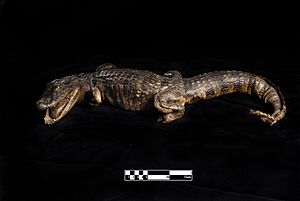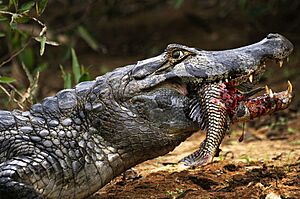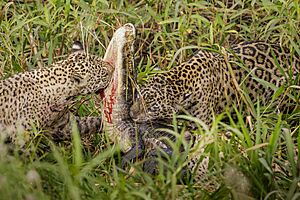Yacare caiman facts for kids
Quick facts for kids Yacare caiman |
|
|---|---|
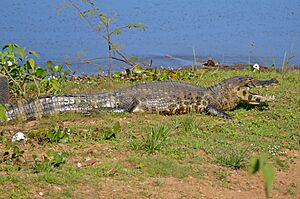 |
|
| Mato Grosso, Brazil | |
| Conservation status | |
| Scientific classification | |
| Genus: |
Caiman
|
| Species: |
yacare
|
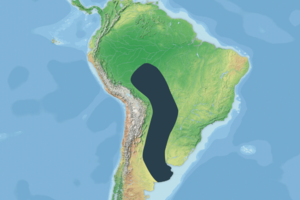 |
|
| Range (black) | |
| Synonyms | |
|
|
The yacare caiman (Caiman yacare) is a type of caiman. It's a crocodilian, which means it's related to alligators and crocodiles. People also call it the jacare caiman or Paraguayan caiman. It lives only in parts of South America, including Argentina, Bolivia, Brazil, and Paraguay.
These caimans are brown and have dark spots all over their bodies. Male yacare caimans can grow to be 2 to 3 meters (about 6.5 to 10 feet) long. They can weigh around 40 to 50 kilograms (about 88 to 110 pounds). Females are smaller, usually about 1.4 meters (4.5 feet) long and weighing 15 to 20 kilograms (33 to 44 pounds). They like to live in lakes, rivers, and wet areas like swamps. Their main food is water animals like snails and fish. Sometimes, they even eat small land animals.
Yacare caimans were hunted a lot in the 1980s for their skin, which was used to make leather. This caused their numbers to drop a lot. But now, there are rules to protect them. Their population has grown back, especially in a huge wetland called the Pantanal. There are about 10 million yacare caimans there! Because of this, they are now listed as a species of least concern by the IUCN Red List, meaning they are not currently in danger of extinction.
Contents
What is a Yacare Caiman?
The yacare caiman was first described by a scientist named François Marie Daudin in 1802. He gave it the scientific name Crocodilus yacare. The word yacare comes from an old Tupi word, jacaré, which means "alligator." This word later became part of Portuguese.
The yacare caiman is one of three types of living caimans in the Caiman group. The other two are the Spectacled caiman and the Broad-snouted caiman. There were also many other types of caimans that are now extinct. Scientists are still trying to figure out the exact family tree of the yacare caiman. It is very similar to the spectacled caiman. Some people even thought it was just a type of spectacled caiman. But because they live in different places, scientists usually consider them separate species.
How Yacare Caimans are Related
Scientists use DNA to understand how animals are related. Here's a simplified look at how the yacare caiman fits into the alligator family:
| Alligatoridae |
|
||||||||||||||||||||||||||||||||||||||||||
Appearance and Size
The yacare caiman is a medium-sized reptile with a brown body. Male caimans are larger than females. They can be 2 to 3 meters (6.5 to 10 feet) long and weigh up to 58 kilograms (128 pounds). Females are smaller, growing to about 1.4 meters (4.5 feet) long and weighing 14 to 23 kilograms (31 to 51 pounds).
When they are born, baby caimans are very small. They are only about 12 to 13 centimeters (about 5 inches) long. Young caimans grow quickly. By the time they are 5 years old, they are about 50 centimeters (20 inches) long. Most of their growth stops by age 15. At this age, females are about 80 centimeters (31 inches) long, and males are over 100 centimeters (39 inches) long.
Unique Features
Yacare caimans have dark marks all over their bodies. You can see three to five dark spots on their lower jaw. Their snout (nose area) is smooth and wide. They also have small bumps on their eyelids and a curved ridge between their eyes. Like some other reptiles, they have bony plates called osteoderms under their scales.
They have many teeth, usually around 74 in total. Some of their lower jaw teeth stick out through holes in their upper jaw. This makes their teeth look very noticeable. Because of this feature, some people call them "piranha caimans," as their teeth can look a bit like a piranha's.
-
A juvenile, about one month old, in the Pantanal, Brazil
Habitat and Diet
Yacare caimans live in places with water, like lakes, rivers, and wetlands. They can also live in other types of environments. If their home is disturbed, groups of caimans might move to a new location together.
Their diet mainly includes animals that live in water. They eat snails, fish, and sometimes snakes. They have also been known to eat larger animals like capybaras. When they hunt for snails, they search in plants floating in the water. They use their strong jaws to break the snail shells.
Life Cycle and Reproduction
Yacare caimans usually breed during the rainy season, from December to February. The female caiman builds a nest in the shape of a mound. She uses mud and rotting plants to make it. A female can lay up to 44 eggs, but usually lays between 22 and 35 eggs. The number of eggs often depends on where she lives.
Female caimans usually guard their nests while the eggs are developing. However, if there are many humans hunting in the area, they might guard less. This can lead to fewer baby caimans hatching. The eggs hatch in March. Baby caimans are very independent from birth. They don't get much help from their parents. Young caimans hide in tall grasses during the day. This protects them from birds like herons and storks, which can eat them. Female caimans become old enough to have babies when they are about 10 to 15 years old. Scientists think yacare caimans might live for about 50 years, similar to other caiman species.
-
Storks, such as this wood stork (right), can prey on juveniles (left)
-
Jaguars occasionally prey on caiman
Where Yacare Caimans Live and How They Are Protected
The yacare caiman lives in northern Argentina, Bolivia, southern Brazil, and Paraguay. It is one of the most common caiman species in South America.
In the 1980s, the yacare caiman was in serious trouble. Hunters killed millions of them for their skin to make leather. They would shoot many caimans at water holes and leave the rest of the bodies behind. Even though caimans have bony plates under their skin, there are some softer spots that can be used for leather. This hunting caused their population to drop dramatically.
In 1992, Brazil put a ban on trading crocodile and caiman skins. This ban helped the yacare caiman population recover a lot. By 2013, there were about 10 million yacare caimans living in the Pantanal wetland alone. Today, some threats to the yacare caiman include cutting down forests, tourism, building dams, and illegal hunting. However, because they reproduce quickly, they are less affected by hunting pressure than some other animals.
The IUCN Red List listed the yacare caiman as a species of "least concern" in 1996. This means they are not currently at high risk of extinction. The United States Fish and Wildlife Service also lists them as threatened, which means they are protected. Since 2010, they are also listed under Appendix II by the Convention on International Trade in Endangered Species. This means their trade is controlled to prevent them from becoming endangered.





